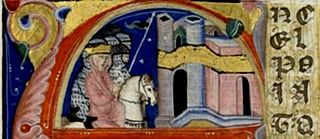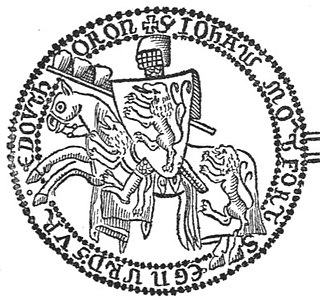Related Research Articles

Aimery of Lusignan, erroneously referred to as Amalric or Amaury in earlier scholarship, was the first King of Cyprus, reigning from 1196 to his death. He also reigned as the King of Jerusalem from his marriage to Isabella I in 1197 to his death. He was a younger son of Hugh VIII of Lusignan, a nobleman in Poitou. After participating in a rebellion against Henry II of England in 1168, he went to the Holy Land and settled in the Kingdom of Jerusalem.

The Kingdom of Jerusalem, also known as the Latin Kingdom, was a Crusader state that was established in the Levant immediately after the First Crusade. It lasted for almost two hundred years, from the accession of Godfrey of Bouillon in 1099 until the fall of Acre in 1291. Its history is divided into two periods with a brief interruption in its existence, beginning with its collapse after the siege of Jerusalem in 1187 and its restoration after the Third Crusade in 1192.

The Eighth Crusade was the second Crusade launched by Louis IX of France, this one against the Hafsid dynasty in Tunisia in 1270. It is also known as the Crusade of Louis IX Against Tunis or the Second Crusade of Louis. The Crusade did not see any significant fighting as Louis died of dysentery shortly after arriving on the shores of Tunisia. The Treaty of Tunis was negotiated between the Crusaders and the Hafsids. No changes in territory occurred, though there were commercial and some political rights granted to the Christians. The Crusaders withdrew back to Europe soon after.
Hugh III, also called Hugh of Antioch-Lusignan and the Great, was the king of Cyprus from 1267 and king of Jerusalem from 1268. Born into the family of the princes of Antioch, he effectively ruled as regent for underage kings Hugh II of Cyprus and Conrad III of Jerusalem for several years. Prevailing over the claims of his cousin Hugh of Brienne, he succeeded both young monarchs upon their deaths and appeared poised to be an effective political and military leader.

Alice of Champagne was the queen consort of Cyprus from 1210 to 1218, regent of Cyprus from 1218 to 1223, and of Jerusalem from 1243 to 1246. She was the eldest daughter of Queen Isabella I of Jerusalem and Count Henry II of Champagne. In 1210, Alice married her step-brother King Hugh I of Cyprus, receiving the County of Jaffa as dowry. After her husband's death in 1218, she assumed the regency for their infant son, King Henry I. In time, she began seeking contacts within her father's counties in France to bolster her claim to Champagne and Brie against her cousin, Theobald IV. However, the kings of France never acknowledged her claim.

The Kingdom of Jerusalem, one of the Crusader states that was created in 1099, was divided into a number of smaller seigneuries. According to the 13th-century jurist John of Ibelin, the four highest crown vassals in the kingdom proper were the count of Jaffa and Ascalon, the prince of Galilee, the lord of Sidon, and the lord of Oultrejordain.
Isabella of Cyprus was a Cypriotic princess. She was the regent of Kingdom of Jerusalem on behalf of her nephew King Hugh II in 1263-1264.
John I was King of Cyprus and, in contention with Charles I of Anjou, of Jerusalem from 1284 to 1285.

The House of Ibelin was a noble family in the Crusader Kingdom of Jerusalem in the 12th century. They rose from humble beginnings to become one of the most important families in the kingdom, holding various high offices and with extensive holdings in the Holy Land and Cyprus. The family disappeared after the fall of the Kingdom of Cyprus in the 15th century.
John of Ibelin, count of Jaffa and Ascalon, was a noted jurist and the author of the longest legal treatise from the Kingdom of Jerusalem. He was the son of Philip of Ibelin, bailli of the Kingdom of Cyprus, and Alice of Montbéliard, and was the nephew of John of Ibelin, the "Old Lord of Beirut". To distinguish him from his uncle and other members of the Ibelin family named John, he is sometimes called John of Jaffa.
Maria of Antioch was a claimant to the throne of the Kingdom of Jerusalem from 1268 to 1277. In 1267 she laid claim to govern the kingdom as regent in the name of the absentee King Conrad III. Her legal case was solid, resting on the proximity of blood to the king, but she was rejected by the High Court of Jerusalem in favor of Hugh III of Cyprus. When Conrad died in 1268, she demanded to be crowned as his successor. Spurned yet again for Hugh, she moved to Europe and eventually sold her claim to Charles I of Anjou.

The principality of Galilee was one of the four major seigneuries of the crusader Kingdom of Jerusalem, according to 13th-century commentator John of Ibelin, grandson of Balian. The direct holdings of the principality centred around Tiberias, in Galilee proper, but with all its vassals, the lordship covered all Galilee and southern Phoenicia. The independent Lordship of Sidon was located between Galilee's holdings. The principality also had its own vassals: the Lordships of Beirut, Nazareth, and Haifa.

Philip Ι of Montfort was Lord of La Ferté-Alais and Castres-en-Albigeois 1228–1270, Lord of Tyre 1246–1270, and Lord of Toron aft. 1240–1270. He was the son of Guy of Montfort and Helvis of Ibelin.
Amalric, Lord of Tyre, also called Amalric of Lusignan or Amaury de Lusignan was a prince and statesman of the House of Lusignan, a younger son of King Hugh III of Cyprus and Isabella of the House of Ibelin. He was given the title of Lord of Tyre in 1291, shortly before the city of Tyre fell to the Mamluks of Egypt. He is often but incorrectly called the Prince of Tyre.

John of Montfort was lord of Toron from 1257 to 1266 and Lord of Tyre from 1270 to 1283. He was the son of Philip of Montfort, and his second wife Maria of Antioch-Armenia.
Eschive d'Ibelin (1253–1312) was suo jure Lady of Beirut in 1282–1312. She was the daughter of John II of Beirut, lord of Beirut, and of Alice de la Roche, and a member of the influential Ibelin family.
Isabella of Ibelin (1252–1282) was lady of Beirut from 1264 until her death in 1282, and also held the title of Queen of Cyprus. She was the daughter of John II of Beirut, lord of Beirut, and of Alice de la Roche sur Ognon.
The Lordship of Tyre was a semi-independent domain in the Kingdom of Jerusalem from 1246 to 1291.

The timeline of the Kingdom of Jerusalem presents important events in the history of the Kingdom of Jerusalem—a Crusader state in modern day Israel and Jordan—in chronological order. The kingdom was established after the First Crusade in 1099. Its first ruler Godfrey of Bouillon did not take the title of king and swore fealty to the Latin Patriarch of Jerusalem, Daimbert. Godfrey's brother and successor Baldwin I was crowned the first king of Jerusalem without doing homage to the patriarch in 1100. By 1153, Baldwin I and his successors captured all towns on the Palestinian coast with the support of Pisan, Genoese and Venetian fleets and also took control of the caravan routes between Egypt and Syria. The kings regularly administered other crusader states—the Counties of Edessa and Tripoli and the Principality of Antioch—on behalf of their absent or underage rulers.

The fall of Outremer describes the history of the Kingdom of Jerusalem from the end of the last European Crusade to the Holy Land in 1272 until the final loss in 1302. The kingdom was the center of Outremer—the four Crusader states—formed after the First Crusade in 1099 and reached its peak in 1187. The loss of Jerusalem in that year began the century-long decline. The years 1272–1302 are fraught with many conflicts throughout the Levant as well as the Mediterranean and Western European regions, and many Crusades were proposed to free the Holy Land from Mamluk control. The major players fighting the Muslims included the kings of England and France, the kingdoms of Cyprus and Sicily, the three Military Orders and Mongol Ilkhanate. Traditionally, the end of Western European presence in the Holy Land is identified as their defeat at the Siege of Acre in 1291, but the Christian forces managed to hold on to the small island fortress of Ruad until 1302.
References
- 1 2 3 4 5 6 Holt 1995, p. 106.
- ↑ Jackson-Laufer 1999, p. 249.
- ↑ Hodgson 2007, p. 126.
- ↑ Runciman 1987, p. 329.
- 1 2 Edbury 2001, p. 26.
- 1 2 3 Crawford 2003, p. 61.
- ↑ Runciman 1987, p. 395.
- ↑ Runciman 1987, p. 421.
